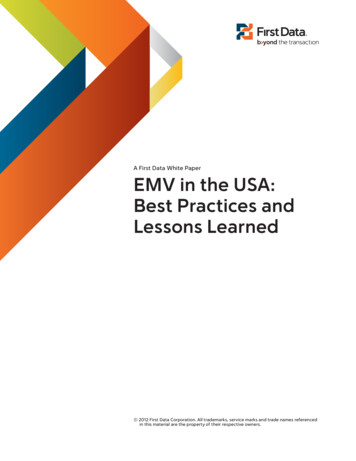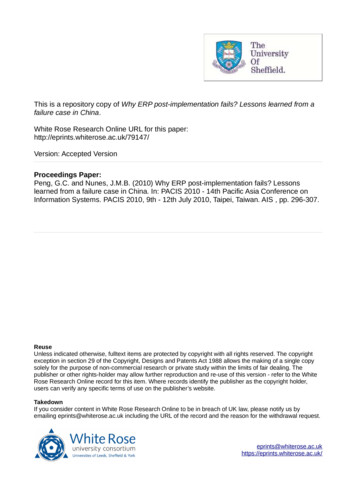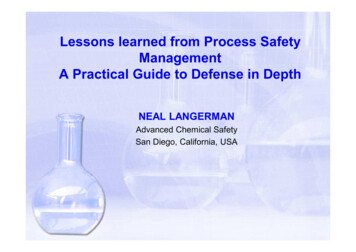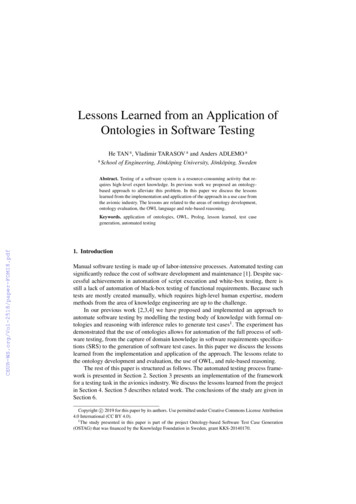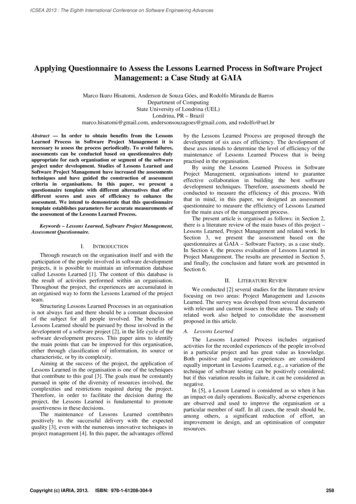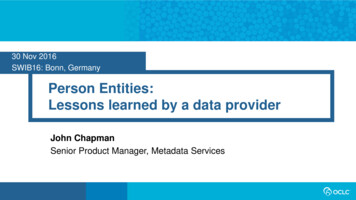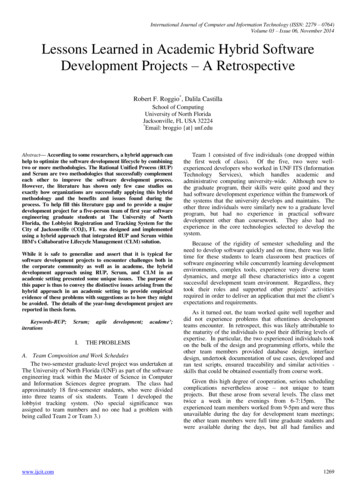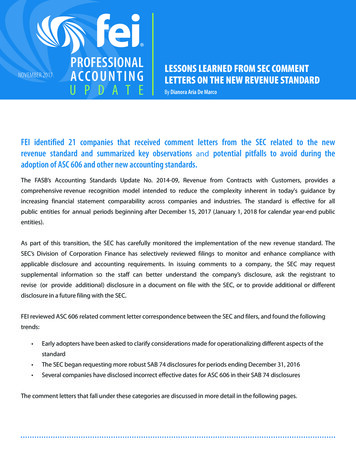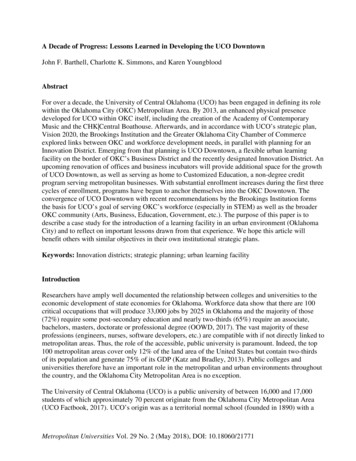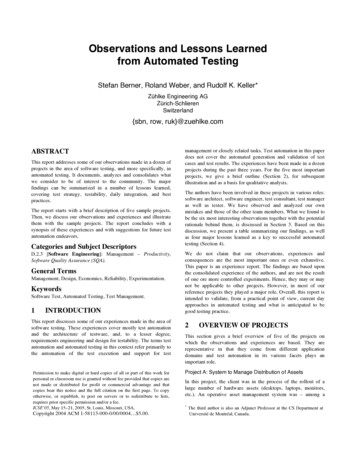
Transcription
Observations and Lessons Learnedfrom Automated TestingStefan Berner, Roland Weber, and Rudolf K. Keller*Zühlke Engineering AGZürich-SchlierenSwitzerland{sbn, row, ruk}@zuehlke.comABSTRACTThis report addresses some of our observations made in a dozen ofprojects in the area of software testing, and more specifically, inautomated testing. It documents, analyzes and consolidates whatwe consider to be of interest to the community. The majorfindings can be summarized in a number of lessons learned,covering test strategy, testability, daily integration, and bestpractices.The report starts with a brief description of five sample projects.Then, we discuss our observations and experiences and illustratethem with the sample projects. The report concludes with asynopsis of these experiences and with suggestions for future testautomation endeavors.Categories and Subject DescriptorsD.2.3 [Software Engineering]: Management – Productivity,Software Quality Assurance (SQA).General TermsManagement, Design, Economics, Reliability, Experimentation.KeywordsSoftware Test, Automated Testing, Test Management.1INTRODUCTIONThis report discusses some of our experiences made in the area ofsoftware testing. These experiences cover mostly test automationand the architecture of testware, and, to a lesser degree,requirements engineering and design for testability. The terms testautomation and automated testing in this context refer primarily tothe automation of the test execution and support for testPermission to make digital or hard copies of all or part of this work forpersonal or classroom use is granted without fee provided that copies arenot made or distributed for profit or commercial advantage and thatcopies bear this notice and the full citation on the first page. To copyotherwise, or republish, to post on servers or to redistribute to lists,requires prior specific permission and/or a fee.ICSE’05, May 15–21, 2005, St. Louis, Missouri, USA.Copyright 2004 ACM 1-58113-000-0/00/0004 5.00.management or closely related tasks. Test automation in this paperdoes not cover the automated generation and validation of testcases and test results. The experiences have been made in a dozenprojects during the past three years. For the five most importantprojects, we give a brief outline (Section 2), for subsequentillustration and as a basis for qualitative analysis.The authors have been involved in these projects in various roles:software architect, software engineer, test consultant, test manageras well as tester. We have observed and analyzed our ownmistakes and those of the other team members. What we found tobe the six most interesting observations together with the potentialrationale behind them, is discussed in Section 3. Based on thisdiscussion, we present a table summarizing our findings, as wellas four major lessons learned as a key to successful automatedtesting (Section 4).We do not claim that our observations, experiences andconsequences are the most important ones or even exhaustive.This paper is an experience report. The findings are based uponthe consolidated experience of the authors, and are not the resultof one ore more controlled experiments. Hence, they may or maynot be applicable to other projects. However, in most of ourreference projects they played a major role. Overall, this report isintended to validate, from a practical point of view, current dayapproaches in automated testing and what is anticipated to begood testing practice.2OVERVIEW OF PROJECTSThis section gives a brief overview of five of the projects onwhich the observations and experiences are based. They arerepresentative in that they come from different applicationdomains and test automation in its various facets plays animportant role.Project A: System to Manage Distribution of AssetsIn this project, the client was in the process of the rollout of alarge number of hardware assets (desktops, laptops, monitors,etc.). An operative asset management system was – among a*The third author is also an Adjunct Professor at the CS Department atUniversité de Montréal, Canada.
couple of other things – the prerequisite for this rollout. Thissystem was intended to keep track of the delivered hardware andtheir configuration in order to feed billing systems. After failedattempts to get the system into production, test specialists shouldidentify the problems and help to get the system productive. Theengagement objective was to establish and develop an effectivequality assurance and testing for a browser based assetmanagement system. Main goals were to identify and isolate theissues, which directly hampered the productive operation. Thetesting work has been performed under specific circumstanceswith respect to a distributed development, an incompleteapplication, incomplete application documentation and very tighttime lines – as said above the rollout was dependent on thesystem.In this project, an XP-like development process was used withstrong involvement of the customer. Flexible responses tochanging requirements and very short release cycles wereessential to the customer, as he had to cope with conflicting andchanging requirements from different national sales departments.Project B: Java-Based Application PlatformIn this project, our client was suffering from long release cycles ofhis safety critical control and information system. The applicationwas designed as a distributed system that could be tailored tomatch customer needs by configuration. The distributedcomponents communicated via a message bus. The systemsupported different hardware platforms, as well as a configurablelook and feel of the user interface.The test strategy therefore emphasized on automated tests atdifferent levels, employing techniques supporting effective testautomation like mock objects, and on daily integration combinedwith the execution of all automated tests. Testware architecturewas considered as a part of the system architecture by thedevelopment team. At the end, test automation code accounted forabout 25% of all code in the system.Project E: System Test Automation for Control SystemThe purpose of this project was the development of an applicationplatform to standardize the development and operation of javaand J2EE-based applications, respectively. Part of the engagementin this project was an assessment of the quality of someframework components (e.g. for logging, auditing) of the platformand an assessment of the current status concerning development,build and test practices.A complete regression test took almost three months, due to thefact that tests had to be repeated on different hardwareconfigurations. Much emphasis was put on the verification of thefailover mechanism, which was at the heart of the system.The analysis was followed by the design and realization of afamily of reference applications to test the components of theplatform. This included documentation in form of (so called)cookbooks, which showed how to build (and test) theseapplications, which are platform conform. The referenceapplications together with automated functional tests were used toanalyze the quality of the platform components. In order to get acomprehensive notion about ‘which parts of the platform wheretouched by the analysis’, tools to measure test coverage [5] andprofilers [7] were used heavily.Our assignment was to automate an existing smoke test suite,which had to be run on two different hardware configurationsonce a week to verify the stability of baseline builds. Another goalof the automation project was to design and implement a testwarearchitecture that could be reused in the automation of a regressiontest suite later.3Project C: Point of Sale System for Life InsurancesThe system to be developed was a distributed point of sale (POS)system, developed for the life insurance division of a large bank[1]. It was intended to assist the sales process of life insurances.This bank intended to enter the life insurance market with acomplete portfolio of products. Instead of building a new salesorganization, the existing infrastructure (branch offices) should beused. Therefore, the POS system should enable finance people andbank clerks to offer and sell life insurances to bank customers.OBSERVATIONS AND EXPERIENCES3.1 Test Automation Strategy IsOften InappropriateA sound testing process is helpful for successful test automation,but an appropriate test (automation) strategy is vital. The teststrategy defines, which test types – e.g. functional tests,performance tests, reliability tests – are to be performed on whichtest level – e.g. unit, integration, etc. – and which tests areautomated and/or supported by tools. Four common mistakes withregard to test automation strategy are listed below:Requirements engineering was based on use cases and onexplorative prototyping. The POS system was realized in acommon multi-tier architecture with a relational database in thebackground, CORBA as middleware, and Java as the mainlanguage to realize both the business components on themiddleware, and the client components in form of a thin client.Misplaced or Forgotten Test TypesTests that are hard to do manually very often are hard to automateas well. Tests situated in the wrong test level usually are hard toexecute, regardless whether they are executed manually orautomatically.Project D: Sales Support for Tailored Industrial FacilitiesOur assignment was to build a family of intranet basedapplications supporting the sales department of a largeinternational company in the industrial sector. The main goal wasto create offers for customized industrial facilities within a shorttime.Tests on different test levels usually have different goals. Unittests generally focus on the program logic within a softwarecomponent and on correct implementation of the componentinterface. It would be very inefficient to test these issues with aGUI based system test approach. It may be difficult to force thesystem under test into system states needed. Or the resulting2
system state cannot be verified accurately, because it is not visibleon the user interface. Additionally, the debugging effort forprogram logic bugs detected during system tests will beconsiderably higher.one approach can be reused for other test types or approaches,thus making a combined strategy even more effective.Tool Usage is Restricted to Test ExecutionStrategies for automated testing often consider only automation oftest execution. Sometimes there is more potential in automatingprocesses in the test lab like installation and configurationprocedures. Additionally, tools may be used to design test cases ortest reports more efficiently. The same is valid when it comes toanalysis and reporting. The appropriate and consequent usage of agood test and change management tool often and easily savesmore than the mere automation of the test execution. These areasare often overlooked, when a test strategy is defined.Many organizations, we have been working in, rely mainly onsystem tests, with only unsystematic unit testing. Integration testsusually are completely neglected. This leads to inefficient testing.Moreover, some aspects like robustness tests, that are notoriouslyhard to test, are usually omitted completely.Wrong ExpectationsMany organizations have unrealistic expectations about thebenefits of test automation. Test automation is intended to save asmuch money as possible spent for ‘unproductive’ testingactivities. They therefore expect a very short ROI on their testautomation investment. If these expectations are not met, testautomation is abandoned quickly.Project ReferencesIn project C, the automated test (execution) nearly failed due towrong expectations. This time from the developer side; it wasexpected to detect more errors through the mere execution of thetest suite. However, the strategy was sufficiently diversified andthe automated functional tests were partially reused to drive aperformance test against the business logic of the system.Automated functional test were based on JUnit and for theperformance test, a decorator based on JUnitPerf [6] had beenused. This saved considerable effort compared with conventional,GUI-based performance testing.There are a few points in test automation that are not that easilyincorporated into ROI calculations, but are strong points forautomating tests:1. Automated testing does allow for shorter release cycles. Testphases can be shortened considerably. Tests may be executedmore often, bugs are detected earlier and costs for bug fixingare reduced.2. The quality and depth of test cases increase considerably,when testers are freed from boring and repetitive tasks. Theyhave more time to design more or better test cases, focusingon areas that have been neglected so far.In project E, complete automation and sufficient diversificationwas not possible due to limitations in the system architecture.Automated test where restricted to the GUI-level. Most of the testcases in the smoke test suite in project E were concerned withverifying that the failover mechanism worked correctly. Bothsimulating a failure and verifying the system response to thisfailure was not always possible. In many cases, it would havebeen easier if the automated tests had interacted directly with thesystem components instead of interacting with the user interfaceonly. However, despite these conceptual problems scarce testingresources could be freed from running the smoke test suitemanually once a week. And most important, the weakness in theautomation strategy has been recognized and will be addressed infuture development cycles.Missing DiversificationOrganizations new to test automation usually have a very cleargoal: saving time, money and most important scarce testingresources. The most natural way to achieve this goal is toautomate whatever the testers have been doing manually so far.Consequently, many organizations start by automating somesubset of their existing GUI based system tests. Frequently, this
Observations and Lessons Learned from Automated Testing Stefan Berner, Roland Weber, and Rudolf K. Keller* Zühlke Engineering AG Zürich-Schlieren Switzerland {sbn, row, ruk}@zuehlke.com ABSTRACT This report addresses some of our observations made in a dozen of projects in the area of software testing, and more specifically, in automated .
